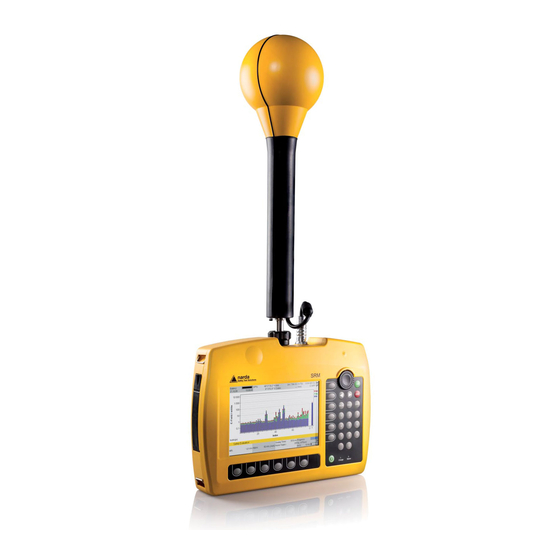
NARDA SRM-3006 Manual
Safety radiation meter
Hide thumbs
Also See for SRM-3006:
- Operating manual (240 pages) ,
- Command reference manual (166 pages) ,
- Manual (25 pages)
Table of Contents
Advertisement
Quick Links
Safety Radiation Meter
SRM-3006
Application Note 1106
Code-selective measurements with the SRM-3006
Using the LTE-TDD option
With firmware release 1.5.0, the SRM 3006 can also demodulate TDD mode LTE
signals. This article provides an overview and describes the main differences with
FDD mode.
Contents
1 The LTE E-UTRA frequency bands ......................................... Page 2
2 The LTE duplex modes ........................................................... Page 3
3 LTE-TDD uplink and downlink configurations .......................... Page 4
4 Using the SRM-3006 LTE-TDD option ..................................... Page 5
5 Further literature ...................................................................... Page 6
AN_1106_SRM_LTE_TDD
Figure 1: Narda SRM-3006
1 / 6
© August 2017
Authors:
Mark Reinhard, Helmut Keller
Sandwiesenstr. 7
Tel.: +49 7121 9732-0
Fax: +49 7121 9732-790
Subject to change
Advertisement
Table of Contents

Summary of Contents for NARDA SRM-3006
-
Page 1: Table Of Contents
Sandwiesenstr. 7 3 LTE-TDD uplink and downlink configurations ......Page 4 72793 Pfullingen, Germany Tel.: +49 7121 9732-0 4 Using the SRM-3006 LTE-TDD option ........Page 5 Fax: +49 7121 9732-790 5 Further literature ..............Page 6 E-mail: info.narda-de@L3T.com www.narda-sts.com... -
Page 2: The Lte E-Utra Frequency Bands
The LTE E-UTRA frequency bands LTE stands for Long Term Evolution. This is the fourth generation of mobile telecommunications networks, called 4G for short. The specification process for LTE began in around 2004, and it took another five years or so until the first LTE networks came on line between 2008 and 2010. -
Page 3: The Lte Duplex Modes
The LTE duplex modes The duplex mode in cellular mobile telecommunications systems such as 2G, 3G and 4G refers to the way communication between the handset and the base station takes place, that is, how the uplink and downlink are separated from each other. -
Page 4: Lte-Tdd Uplink And Downlink Configurations
Figure 2. A protocol is also required for this, to ensure that the uplink and downlink in TDD alternate without conflicts. Such a protocol is likely to be quite complex for a modern communication technology like LTE. It can be illustrated simply as being like a conversation between two persons using a simple walkie-talkie link operating on one frequency. -
Page 5: Using The Srm-3006 Lte-Tdd Option
Using the SRM 3006 LTE-TDD option It is now also possible to demodulate LTE TDD signals on the SRM 3006 with firmware release 1.5.0. Sections 1 to 3 above have described how LTE TDD functions differently to LTE FDD and how it therefore needs different treatment in the SRM. -
Page 6: Further Literature
E-mail: info.narda-de@L3T.com www.narda-sts.us www.narda-sts.it www.narda-sts.com ® N ames and logo are registered trademarks of Narda Safety Test Solutions GmbH and L3 Communications Holdings, Inc. – Trade names are the trademarks of their respective owners. AN_1106_SRM_LTE_TDD 6 / 6 Subject to change...
















Need help?
Do you have a question about the SRM-3006 and is the answer not in the manual?
Questions and answers